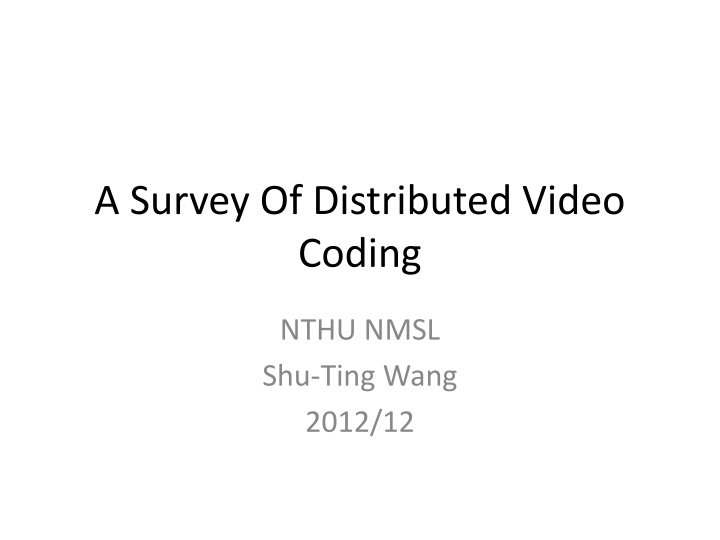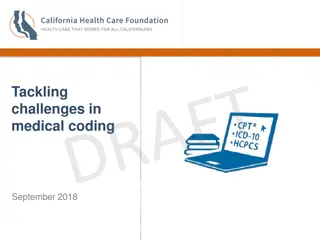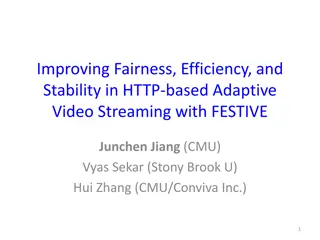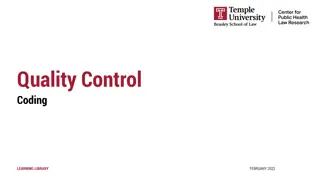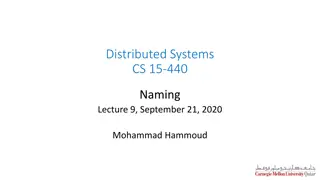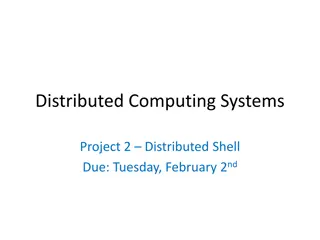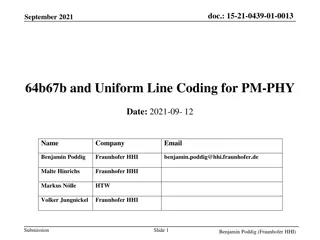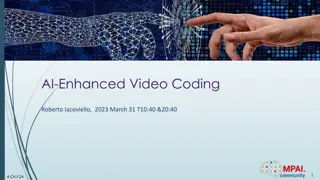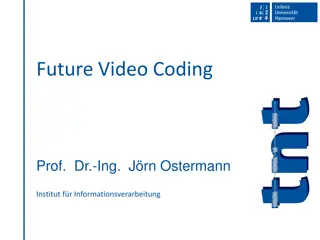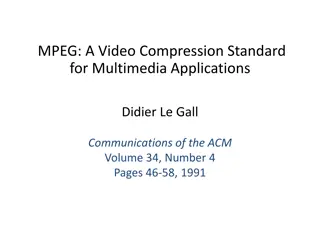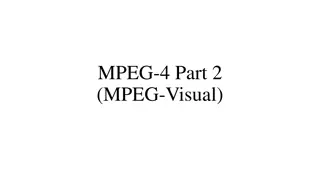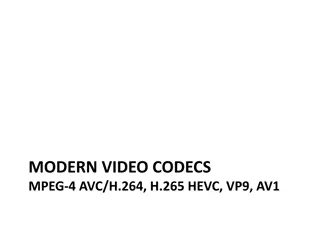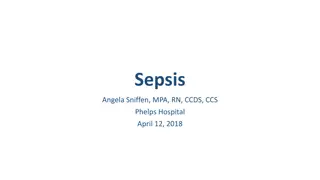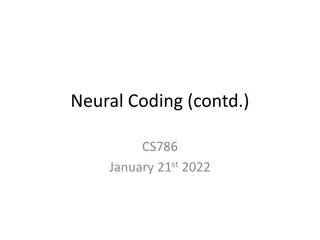Survey of Distributed Video Coding Progress
This survey delves into the advancements of distributed video coding, exploring key theories, architectures, and future research in this field. The content covers topics like joint encoding, separate decoding, PRISM, Stanford architecture, and more.
Download Presentation

Please find below an Image/Link to download the presentation.
The content on the website is provided AS IS for your information and personal use only. It may not be sold, licensed, or shared on other websites without obtaining consent from the author.If you encounter any issues during the download, it is possible that the publisher has removed the file from their server.
You are allowed to download the files provided on this website for personal or commercial use, subject to the condition that they are used lawfully. All files are the property of their respective owners.
The content on the website is provided AS IS for your information and personal use only. It may not be sold, licensed, or shared on other websites without obtaining consent from the author.
E N D
Presentation Transcript
A Survey Of Distributed Video Coding NTHU NMSL Shu-Ting Wang 2012/12
Abstract Introduction System Framework DISCOVER Codecs Recent Research and Future work
Abstract Introduction System Framework DISCOVER Codecs Recent Research and Future work
Which Theories? Slepian and Wolf for lossless distributed source coding Wyner and Ziv for the lossy distributed source coding
Basics(1/4) the rate-distortion performance achieved when performing joint encoding and decoding of two correlated sources can also be obtained by doing separate encoding and joint decoding
Basics(2/4) the sum of rates,??+ ??, can achieve the joint entropy H ( X, Y ), just as for joint encoding of X and Y , despite separate encoders for X and Y .
Basics(3/4) The source produces a sequence X with statistics that depend on side information Y which improve decoding.
Basics(4/4) We are interested in the case where Y is available at the decoder, but not at the decoder.
Abstract Introduction System Framework DISCOVER Codecs Recent Research and Future work
Early Architectures Two kinds of architecture PRISM Stanford Nowadays, state-of-the-art codecs are based on Stanford architecture because of its efficiency.
Frame Splitting Input frames are split into two parts Key Frames Wyner-Ziv Frames Key frames are coded by MPEG/H.264 intra to prevent error drifting problem
Discrete Cosine Transform(1/2) DCT has good energy compaction property and human eyes can hardly perceive the high frequency bands. The transform-domain DVC codec has shown its better R-D performance than the pixel- domain one
Quantization(1/3) Sampled signal Quantized signal Digital signal (sampled, quantized)
Quantization(2/3) Q table is simple for implementation, it cannot keep the coding quality on various video sequences. Stanford-based DVC codecs have the Q table for quantization like traditional video codecs
Quantization(3/3) PRISM employing the classification method Low correlation : use conventional coding High correlation: skip Other: distributed coding
Encoder PRISM codec do more on encoder to achieve better rate-distortion performance. Encoder can generate hash code for decoder (hash-based motion estimation) to choose better side information.
Channel Coding(1/2) Turbo code or LDPC code are usually used to encode the quantized bands bit-plane by bit- plane. Parity bitstreams (or syndrome bits) are kept in the buffer. Rate estimator will determine how many parity bits to be sent to the decoder.
Channel Coding(2/2) Cyclic Redundancy Check (CRC) is used to verify the correctness of the decoded bands. Obvious disadvantage: the iterative decoding process cause significant delay. Many research are focus on rate estimation and reducing the number of feedback
Side Information The key operation of the side information generation is motion-compensated frame interpolation or hash-based motion estimation , where true motion field is required to get the best quality. The quality of Wyner-Ziv frames is strongly determined by the the side information.
Correlation Noise Modeling(1/2) DVC systems usually use Laplacian distribution to model the bit conditional probability of bit- planes for decoding.
Correlation Noise Modeling(2/2) A good correlation noise model leads to better R-D performance. Early methods are offline training methods. Online modeling and TRACE( transfrom- domain adaptive correlation estimation) are purposed to improve the modeling algorithm.
Reconstruction and Post-processing The minimum min square error (MMSE) method and Inverse DCT are applied to get the optimal decoded frames. The deblocking filter technique in traditional codec can be adopted to DVC system.
Abstract Introduction System Framework DISCOVER Codecs Recent Research and Future work
Frame Splitting For the DISCOVER codec, an adaptive Group of Picture (GOP)size selection module was developed to control the (non-periodic) insertion of key frames in between the WZ frames.
Channel Encoder and Buffer(1/2) The LDPCA codes are better than the turbo codes at the capacity of many communication channels, including the virtual channel in DVC. An LDPCA encoder consists of LDPC syndrome-former accumulator If the decoder fails, more accumulated syndromes are requested from the encoder buffer using a feedback channel.
Channel Encoder and Buffer(2/2) If the decoder fails, more accumulated syndromes are requested from the encoder buffer using a feedback channel.
Frame Interpolation Framework(1/5) Previous Key frames Low pass filter Interpolated frames Motion Vector Bi-Directional Motion Compensation Forward Motion Estimation Bi-Directional Motion Estimation Spatial Smoothing Next Key frames Low pass filter
Forward Motion Estimation(2/5) Forward Motion Estimation ,the rigid block based motion estimation scheme, fails to capture all aspects of the motion field Once the frame interpolation is performed, overlapped and uncovered areas will appear.
Bi-Directional Motion Estimation(3/5) This motion estimation technique selects a linear trajectory between the next and previous key frames passing at the center of the blocks in the interpolated frame.
Spatial Smoothing(4/5) Sometimes the motion vectors have low spatial coherence. This can be improved by weighted vector median filters, which maintains the motion field spatial coherence by looking for candidate motion vectors at neighboring blocks at each block.
Bi-Directional Motion Compensation(5/5) When final motion vector field is obtained, the interpolated frame can be filled by using bidirectional motion compensation as defined in standard video coding schemes.
Virtual Channel Model & Soft Input Calculation The DISCOVER codec uses a Laplacian distribution to model the correlation noise, i.e. the error distribution between corresponding DCT bands of SI and WZ frames. The DISCOVER codec estimate the Laplacian distribution parameter at the DCT band level and at the coefficient level.
